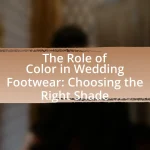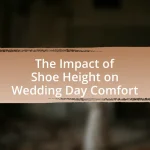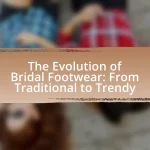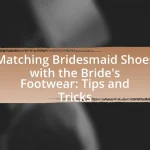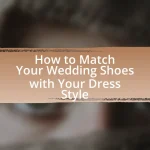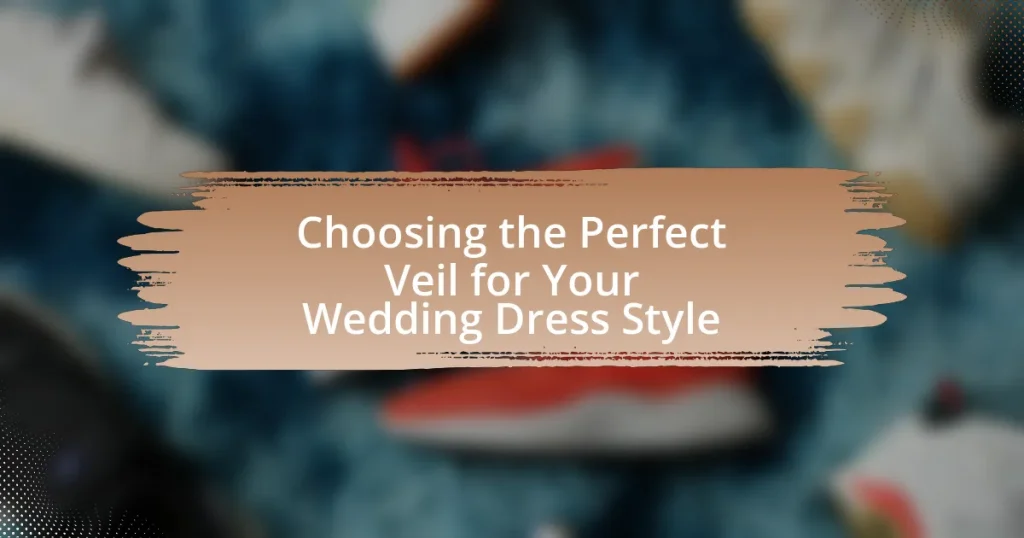The article focuses on the essential factors to consider when selecting a veil that complements a wedding dress style. Key aspects include the veil’s length, fabric, and embellishments, which should harmonize with the dress’s silhouette and material. Different wedding dress styles, such as A-line, ball gown, and mermaid, influence veil choices, while various materials like lace, tulle, and chiffon offer distinct aesthetic qualities. The article also addresses how to align veil selection with wedding themes, ensuring a cohesive bridal look, and provides practical tips for comfort and functionality during the wedding day.
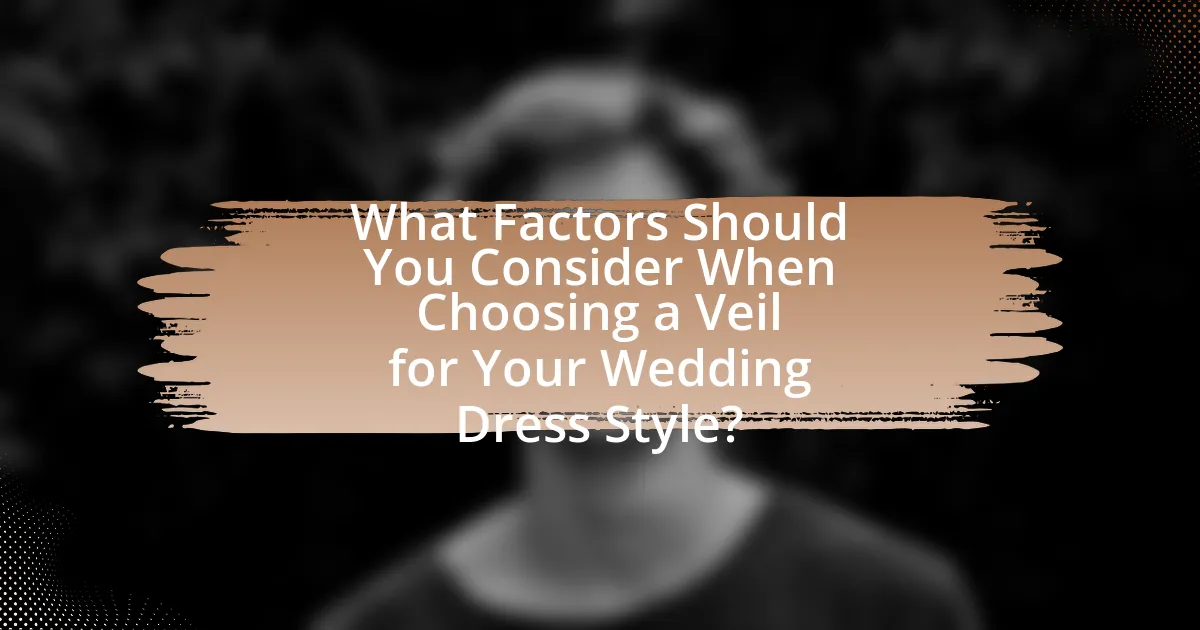
What Factors Should You Consider When Choosing a Veil for Your Wedding Dress Style?
When choosing a veil for your wedding dress style, consider the length, fabric, and embellishments of the veil to ensure harmony with the dress. The length of the veil should complement the dress’s silhouette; for example, a long train may pair well with a cathedral veil, while a shorter dress might suit a birdcage veil. The fabric of the veil, such as tulle or lace, should match or enhance the dress material, ensuring a cohesive look. Additionally, embellishments like beading or embroidery on the veil should align with the dress’s details to create a unified aesthetic. These factors are essential for achieving a balanced and elegant bridal appearance.
How does your wedding dress style influence your veil choice?
The style of your wedding dress significantly influences your veil choice by determining the length, fabric, and embellishments that will complement the overall look. For instance, a ball gown typically pairs well with a long, dramatic veil that adds to the grandeur, while a sleek, modern dress may be better suited for a shorter, simpler veil that maintains a streamlined silhouette. Additionally, intricate lace details on a dress may call for a veil with similar lace patterns to create a cohesive appearance. This alignment between the dress and veil enhances the visual harmony of the bridal ensemble, ensuring that both elements work together seamlessly.
What are the different wedding dress styles and their characteristics?
Wedding dress styles include A-line, ball gown, mermaid, sheath, and tea-length, each characterized by distinct silhouettes and design elements. The A-line dress features a fitted bodice that gradually flares out from the waist, creating a shape reminiscent of the letter “A,” making it flattering for various body types. The ball gown style has a fitted bodice and a full, voluminous skirt, often made of layers of tulle or organza, ideal for a traditional, fairy-tale look. The mermaid dress hugs the body from the chest to the knee and then flares out, emphasizing curves and creating a dramatic effect. The sheath dress is form-fitting and falls straight down from the neckline to the hem, offering a sleek and modern appearance. Lastly, the tea-length dress typically falls between the knee and ankle, providing a vintage or retro vibe, often chosen for casual or outdoor weddings. Each style serves different aesthetics and body types, allowing brides to select a dress that best reflects their personal style and wedding theme.
How do different dress silhouettes affect veil length and style?
Different dress silhouettes significantly influence veil length and style. For example, A-line dresses typically pair well with longer veils, such as cathedral or chapel lengths, which complement the flowing lines of the silhouette. In contrast, fitted silhouettes like mermaid or sheath dresses often look best with shorter veils, such as birdcage or fingertip lengths, to avoid overwhelming the streamlined shape. Ball gown silhouettes can accommodate both long and short veils, but longer veils tend to enhance the dramatic effect of the voluminous skirt. These pairings are based on the principle that the veil should harmonize with the dress’s shape, ensuring a balanced and cohesive look.
What materials are commonly used for wedding veils?
Common materials used for wedding veils include tulle, lace, organza, chiffon, and silk. Tulle is a lightweight, net-like fabric that provides a soft and airy appearance, making it a popular choice for veils. Lace adds a romantic and intricate detail, often used for edges or overlays. Organza is a crisp, sheer fabric that holds its shape well, while chiffon offers a flowing and delicate look. Silk, known for its luxurious feel and sheen, is also favored for high-end veils. These materials are chosen based on their aesthetic qualities and how they complement various wedding dress styles.
How do different veil fabrics complement various dress styles?
Different veil fabrics enhance various dress styles by aligning their texture, weight, and drape with the gown’s design elements. For instance, lace veils complement intricate, vintage-style dresses by echoing their detailed embellishments, while tulle veils pair well with ball gown silhouettes due to their lightweight and voluminous nature, adding a romantic touch. Additionally, silk veils provide a luxurious finish that suits sleek, modern dresses, as their smooth texture enhances the gown’s clean lines. The choice of fabric directly influences the overall aesthetic, ensuring harmony between the veil and the dress style.
What are the pros and cons of lace, tulle, and chiffon veils?
Lace veils offer elegance and a vintage aesthetic, making them popular for formal weddings; however, they can be heavier and less breathable than other materials. Tulle veils are lightweight and versatile, providing a soft and romantic look, but they may lack the intricate detailing found in lace. Chiffon veils are flowy and delicate, creating a soft silhouette, yet they can be more prone to wrinkling and may not hold their shape as well as lace or tulle.
What lengths and styles of veils are available?
Veils are available in various lengths and styles, including fingertip, chapel, cathedral, birdcage, and blusher. Fingertip veils typically reach the fingertips, chapel veils extend to the floor, and cathedral veils are longer, often trailing behind the bride. Birdcage veils are short and cover part of the face, while blusher veils are worn over the face and are usually shorter. Each style complements different wedding dress designs, enhancing the overall bridal look.
What are the different types of veils and their typical lengths?
The different types of veils include the birdcage veil, elbow-length veil, fingertip veil, chapel veil, and cathedral veil, each with typical lengths ranging from 9 inches to 120 inches. The birdcage veil is usually about 9 to 12 inches long, the elbow-length veil measures around 25 to 30 inches, the fingertip veil is approximately 36 to 40 inches, the chapel veil typically ranges from 90 to 108 inches, and the cathedral veil extends from 108 to 120 inches. These lengths are standard in bridal fashion, providing options that complement various wedding dress styles.
How do you choose the right veil length for your dress?
To choose the right veil length for your dress, consider the style and silhouette of your wedding gown. A fingertip veil complements a fitted dress, while a cathedral veil pairs well with a ball gown, creating a dramatic effect. The length should also align with your height; taller brides may opt for longer veils, while shorter brides might choose mid-length options to avoid overwhelming their frame. Additionally, consider the venue and formality of the wedding; a longer veil suits formal settings, while shorter veils are ideal for casual ceremonies.
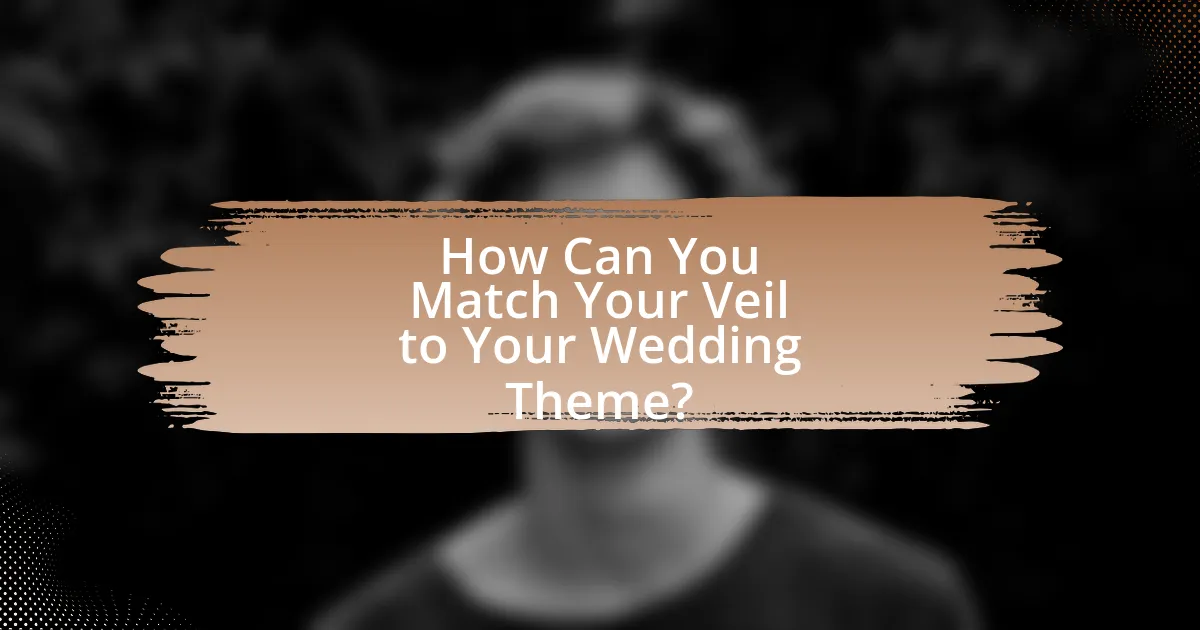
How Can You Match Your Veil to Your Wedding Theme?
To match your veil to your wedding theme, select a veil style, fabric, and embellishments that complement the overall aesthetic of your wedding. For instance, if your wedding theme is vintage, consider a lace veil with intricate detailing, as lace is often associated with classic elegance. Conversely, for a modern theme, a sleek, minimalist veil made of silk or tulle can enhance a contemporary look. Additionally, the color of the veil should align with your wedding palette; for example, a soft ivory veil pairs well with a romantic color scheme. This approach ensures that the veil not only enhances your bridal look but also harmonizes with the wedding’s overall design and atmosphere.
What role does your wedding theme play in veil selection?
The wedding theme significantly influences veil selection by dictating the style, fabric, and embellishments that complement the overall aesthetic. For instance, a vintage-themed wedding may call for lace veils with intricate detailing, while a modern theme might favor sleek, minimalist designs. The choice of veil should align with the colors, motifs, and atmosphere of the wedding, ensuring a cohesive look. This alignment enhances the visual harmony of the bridal ensemble, making the veil an integral part of the overall theme rather than an afterthought.
How can you align your veil choice with a traditional wedding theme?
To align your veil choice with a traditional wedding theme, select a veil that complements classic elements such as lace, tulle, or silk. Traditional weddings often feature veils that are long, flowing, and intricately designed, reflecting historical styles. For instance, a cathedral-length veil adorned with lace trim can enhance a vintage or formal gown, while a simple elbow-length veil may suit a more understated traditional look. Historical context shows that veils have been worn in weddings for centuries, symbolizing modesty and purity, which reinforces their significance in traditional ceremonies.
What are some tips for selecting a veil for a modern or bohemian wedding?
To select a veil for a modern or bohemian wedding, prioritize the veil’s length and style to complement the dress. For modern weddings, sleek, minimalistic veils in materials like silk or tulle work well, while bohemian styles benefit from lace or floral embellishments that enhance a relaxed aesthetic. Additionally, consider the veil’s color; opting for shades that match or harmonize with the dress can create a cohesive look. The choice of embellishments, such as beads or embroidery, should reflect the overall theme of the wedding, ensuring that the veil enhances rather than overwhelms the bridal ensemble.
How do colors and embellishments affect veil choice?
Colors and embellishments significantly influence veil choice by determining the overall aesthetic and harmony of the bridal look. For instance, a veil in a shade that complements the wedding dress enhances visual cohesion, while contrasting colors can create a striking effect. Embellishments such as lace, beading, or embroidery on the veil can echo similar details on the dress, reinforcing the theme and style. According to bridal fashion experts, selecting a veil that aligns with the dress’s color palette and embellishments ensures a unified appearance, making the bride’s ensemble more visually appealing.
What color veils work best with different wedding dress shades?
White veils work best with traditional white wedding dresses, while ivory veils complement ivory dresses effectively. For champagne or blush wedding dresses, veils in similar soft tones enhance the overall look. Light pastel veils, such as pale pink or lavender, pair beautifully with colored wedding dresses, creating a harmonious appearance. Darker shades like navy or burgundy veils can add a striking contrast to lighter dress shades, providing a bold statement. These combinations are based on color theory principles, which suggest that analogous colors create a cohesive look, while complementary colors can add visual interest.
How can embellishments on a veil enhance or clash with your dress?
Embellishments on a veil can enhance a dress by complementing its design elements, such as lace patterns or beadwork, creating a cohesive look. For instance, if a wedding dress features intricate lace, a veil adorned with similar lace embellishments can unify the overall aesthetic, making the ensemble visually appealing. Conversely, embellishments can clash with a dress if they introduce conflicting styles or colors, such as a heavily sequined veil paired with a simple, understated gown, which can create visual dissonance. This principle is supported by fashion design guidelines that emphasize harmony in bridal attire, indicating that matching embellishments can elevate the overall appearance while mismatched elements can detract from it.
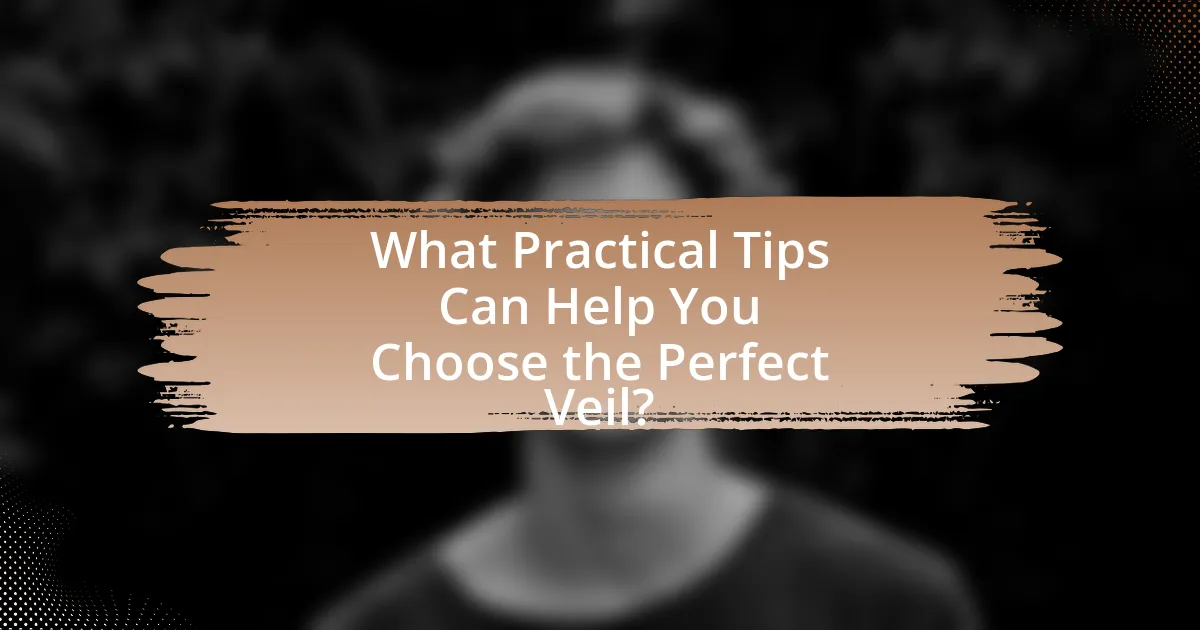
What Practical Tips Can Help You Choose the Perfect Veil?
To choose the perfect veil, consider the length, style, and fabric that complement your wedding dress. The veil’s length should harmonize with the dress’s silhouette; for example, a long cathedral veil pairs well with a formal gown, while a shorter veil suits a casual dress. Additionally, the style of the veil should reflect the overall theme of the wedding; lace or embellished veils enhance a vintage look, while simple tulle works for a modern aesthetic. The fabric choice is also crucial; heavier fabrics like satin provide structure, while lighter materials like chiffon create a soft, ethereal effect. These considerations ensure that the veil enhances the overall bridal look, creating a cohesive appearance on the wedding day.
How can you ensure comfort and functionality with your veil?
To ensure comfort and functionality with your veil, select lightweight materials such as tulle or chiffon that allow for breathability and ease of movement. These fabrics are less likely to cause discomfort during extended wear, making them ideal for long ceremonies and receptions. Additionally, consider the veil’s length and style; shorter veils or those with a comb attachment can provide better stability and prevent tangling, enhancing overall usability. Research indicates that brides who prioritize comfort in their veil choice report higher satisfaction during their wedding day, as they can enjoy their celebration without constant adjustments or discomfort.
What should you consider regarding veil weight and attachment methods?
When considering veil weight and attachment methods, it is essential to match the veil’s weight to the hairstyle and the overall wedding dress style. A heavier veil may require more secure attachment methods, such as combs or pins, to prevent slipping, while lighter veils can often be attached with simple clips or ties. For instance, a cathedral-length veil, which is typically heavier, benefits from a comb for stability, ensuring it stays in place throughout the ceremony. Conversely, a lightweight fingertip veil can be effectively secured with a simple hairpin. This alignment between veil weight and attachment method is crucial for both comfort and aesthetic appeal during the wedding.
How can you test the veil’s comfort during your wedding day activities?
To test the veil’s comfort during wedding day activities, wear the veil during a trial run of your wedding day schedule. This includes walking, sitting, and dancing while wearing the veil to assess how it feels in various situations. Engaging in these activities allows you to identify any discomfort or restrictions caused by the veil, ensuring it does not hinder your movements or cause irritation. Additionally, consider the veil’s weight and how it interacts with your hairstyle, as these factors significantly impact comfort throughout the day.
What are some common mistakes to avoid when choosing a veil?
Common mistakes to avoid when choosing a veil include selecting a length that does not complement the wedding dress, failing to consider the venue’s style, and neglecting to match the veil’s fabric with the dress material. Choosing a veil that is too long or too short can disrupt the overall silhouette, while mismatching styles can create a disjointed look. Additionally, ignoring the veil’s weight and how it interacts with the dress can lead to discomfort or an unflattering appearance.
How can you prevent mismatching your veil with your dress?
To prevent mismatching your veil with your dress, ensure that both items share a similar color palette and fabric type. Selecting a veil that complements the dress’s fabric, such as lace or tulle, enhances cohesion. For instance, if your dress is made of satin, a satin veil will create a harmonious look. Additionally, consider the embellishments on your dress; if it features intricate beadwork, choose a veil with subtle detailing that echoes this design. This approach minimizes the risk of visual discord and creates a unified bridal appearance.
What should you avoid in terms of veil length and style for your body type?
Avoid long, heavy veils if you have a petite body type, as they can overwhelm your frame and create an unbalanced look. For curvier body types, avoid veils that are too short, as they may accentuate areas you prefer to downplay. Additionally, avoid styles with excessive embellishments if you have a more structured silhouette, as they can add unnecessary bulk. These guidelines help ensure that the veil complements your body type rather than detracts from it.

